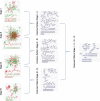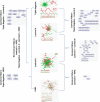Discovering gene re-ranking efficiency and conserved gene-gene relationships derived from gene co-expression network analysis on breast cancer data
- PMID: 26892392
- PMCID: PMC4759568
- DOI: 10.1038/srep20518
Discovering gene re-ranking efficiency and conserved gene-gene relationships derived from gene co-expression network analysis on breast cancer data
Abstract
Systemic approaches are essential in the discovery of disease-specific genes, offering a different perspective and new tools on the analysis of several types of molecular relationships, such as gene co-expression or protein-protein interactions. However, due to lack of experimental information, this analysis is not fully applicable. The aim of this study is to reveal the multi-potent contribution of statistical network inference methods in highlighting significant genes and interactions. We have investigated the ability of statistical co-expression networks to highlight and prioritize genes for breast cancer subtypes and stages in terms of: (i) classification efficiency, (ii) gene network pattern conservation, (iii) indication of involved molecular mechanisms and (iv) systems level momentum to drug repurposing pipelines. We have found that statistical network inference methods are advantageous in gene prioritization, are capable to contribute to meaningful network signature discovery, give insights regarding the disease-related mechanisms and boost drug discovery pipelines from a systems point of view.
Figures























Similar articles
-
Correlating transcriptional networks with pathological complete response following neoadjuvant chemotherapy for breast cancer.Breast Cancer Res Treat. 2015 Jun;151(3):607-18. doi: 10.1007/s10549-015-3428-x. Epub 2015 May 16. Breast Cancer Res Treat. 2015. PMID: 25981901
-
Pathway Relevance Ranking for Tumor Samples through Network-Based Data Integration.PLoS One. 2015 Jul 28;10(7):e0133503. doi: 10.1371/journal.pone.0133503. eCollection 2015. PLoS One. 2015. PMID: 26217958 Free PMC article.
-
Identification of hub subnetwork based on topological features of genes in breast cancer.Int J Mol Med. 2015 Mar;35(3):664-74. doi: 10.3892/ijmm.2014.2057. Epub 2014 Dec 30. Int J Mol Med. 2015. PMID: 25573623 Free PMC article.
-
Systematic drug perturbations on cancer cells reveal diverse exit paths from proliferative state.Oncotarget. 2016 Feb 16;7(7):7415-25. doi: 10.18632/oncotarget.7294. Oncotarget. 2016. PMID: 26871731 Free PMC article.
-
Network-Oriented Approaches to Anticancer Drug Response.Methods Mol Biol. 2017;1513:101-117. doi: 10.1007/978-1-4939-6539-7_8. Methods Mol Biol. 2017. PMID: 27807833 Review.
Cited by
-
Associating expression and genomic data using co-occurrence measures.Biol Direct. 2019 May 9;14(1):10. doi: 10.1186/s13062-019-0240-2. Biol Direct. 2019. PMID: 31072345 Free PMC article.
-
Differential Regulatory Analysis Based on Coexpression Network in Cancer Research.Biomed Res Int. 2016;2016:4241293. doi: 10.1155/2016/4241293. Epub 2016 Aug 11. Biomed Res Int. 2016. PMID: 27597964 Free PMC article. Review.
-
Knowledge-guided analysis of "omics" data using the KnowEnG cloud platform.PLoS Biol. 2020 Jan 23;18(1):e3000583. doi: 10.1371/journal.pbio.3000583. eCollection 2020 Jan. PLoS Biol. 2020. PMID: 31971940 Free PMC article.
-
Drug Repositioning and Subgroup Discovery for Precision Medicine Implementation in Triple Negative Breast Cancer.Cancers (Basel). 2021 Dec 14;13(24):6278. doi: 10.3390/cancers13246278. Cancers (Basel). 2021. PMID: 34944904 Free PMC article.
-
Insight into Mantle Cell Lymphoma Pathobiology, Diagnosis, and Treatment Using Network-Based and Drug-Repurposing Approaches.Int J Mol Sci. 2024 Jul 2;25(13):7298. doi: 10.3390/ijms25137298. Int J Mol Sci. 2024. PMID: 39000404 Free PMC article.
References
MeSH terms
Substances
LinkOut - more resources
Full Text Sources
Other Literature Sources
Medical

